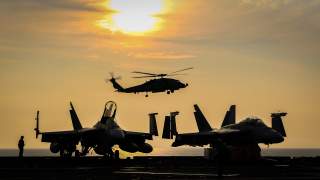Wanted: A Strategy for the Indo-Pacific Region
Indo-Pacific leaders fear that the United States is not wholly committed to a role in the region.
This approach will fundamentally change the nature of U.S. engagement in the region. Instead of preaching the benefits of free economies, the United States will demonstrate it by establishing relationships of mutual benefit. Those who find common interests for collaboration enjoy the benefits that serve as advertisements for the value of an Indo-Pacific region that is free and open.
An Interest-Based Indo-Pacific
As President Trump stated at the Asia-Pacific Economic Cooperation CEO Summit last year, he expects all leaders to put the interests of their own countries first. Not only is it the proper function of a state to protect its own interests, it the necessary precondition for successful cooperation. Only by identifying where interests intersect can parties trade or cooperate to mutual benefit. The FOIP promotes these ideas by advocating that states and individuals should rightfully be free from coercion and free to pursue their interests. Similarly, it advances openness so the linkages required for effective trade and cooperation are unimpeded. However, current descriptions of the FOIP lack tools for implementing this vision of an interest-based Indo-Pacific. CCIs provide those tools—the strategic means—to enable the FOIP to tie the region together through cooperation.
As the United States expanded across the North American continent, Alexis de Tocqueville, a French political theorist, was impressed by the way multiple, independently formed, and cross-cutting associations—from knitting groups, to commercial clubs, to political parties—wove the early American Republic into a stable fabric of diverse individuals, who cooperated where their interests aligned. Similarly, CCIs can build the Indo-Pacific region into a quilt of shared interests that wraps the region in security, comforts individuals with stability, and enables them to pursue their individual prosperity in an environment of free interaction and open commerce.
To ensure this open environment has longevity, an anchor is necessary, not only for the FOIP in general, but to help tie CCIs into a framework. ASEAN, therefore, will sit in the middle of this quilt—at the crossroads of the Indo-Pacific region—and ensure disagreements are handled through dialogue and respect for individual actors. The United States, as the region’s security partner of choice, will need to work closely with ASEAN to ensure member states are convinced of the value of this regional approach and brought into multiple, overlapping CCIs that are tied back to one or more existing ASEAN dialogue forum.
Building on its history of cooperation, dialogue, free association, and finding shared-interests, ASEAN can serve as the loom on which the FOIP is woven. But without connective threads, the FOIP and ASEAN risk having little impact on the regional-security architecture. CCIs provide a rapidly actionable tool to link the region together, act along the themes Secretary Mattis outlined, and achieve the principles that will transform the FOIP from talking points into a new, cooperative regional-security architecture.
DISCLAIMER: The views expressed in this article are those of the author and do not reflect the official policy or position of the Daniel K. Inouye Asia-Pacific Center for Security Studies, the Department of Defense, or the U.S. government.
Lt. Col. McDonald is a tank officer and China Foreign Area Officers in the U.S. Marine Corps. He has served in multiple attaché and operational tours in the Indo-Pacific and is currently a Military Professor at the Daniel K Inouye Asia-Pacific Center for Security Studies in Honolulu, HI.
Image: A U.S. Navy MH-60S Sea Hawk helicopter assigned to the Indians of Helicopter Sea Combat Squadron (HSC) 6 prepares to land on the flight deck of the aircraft carrier USS Theodore Roosevelt (CVN 71) in the Indian Ocean Nov. 24, 2017. Theodore Roosevelt was deployed in support of maritime security operations and theater security cooperation efforts. Flickr / U.S. Department of Defense

